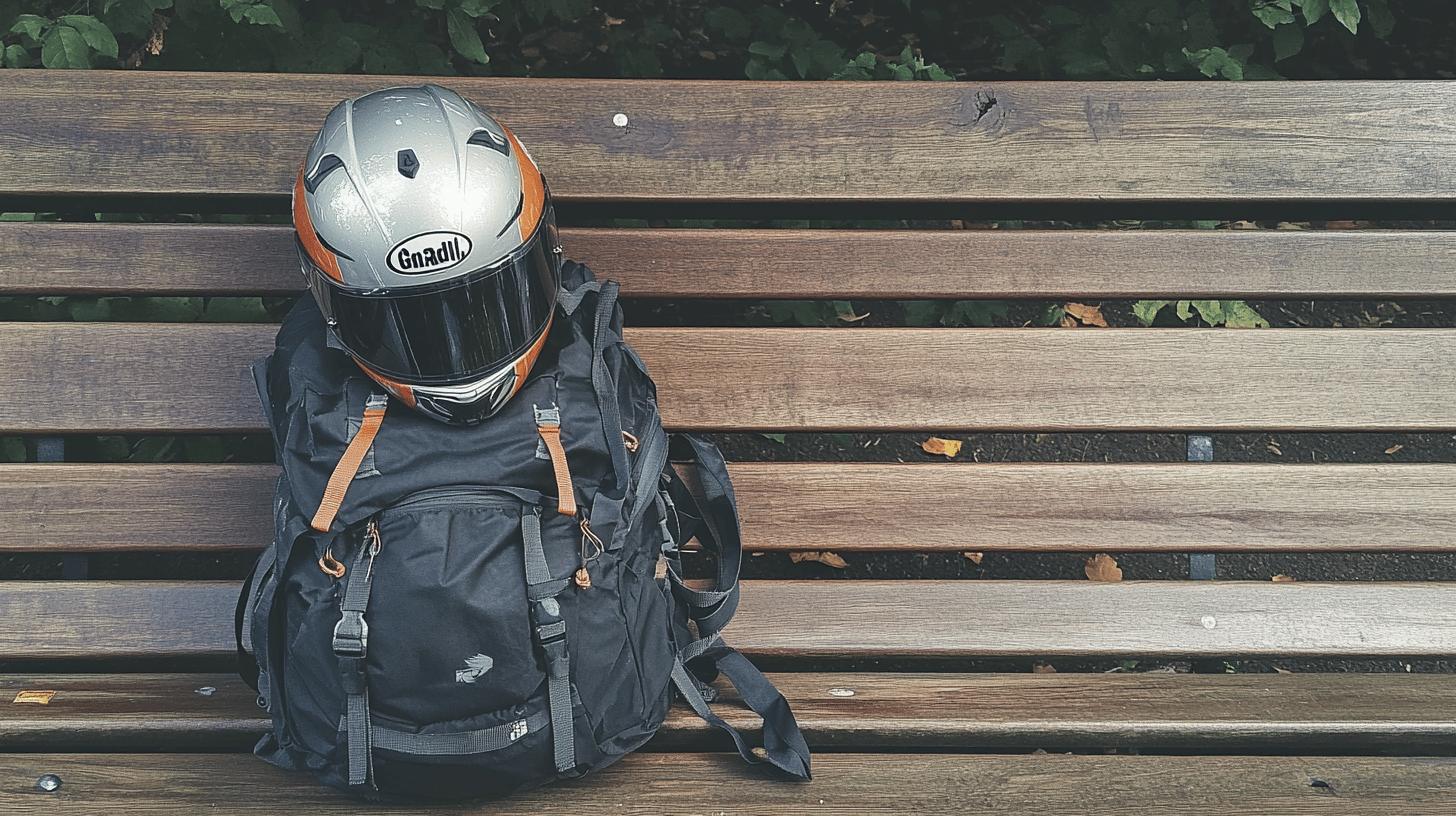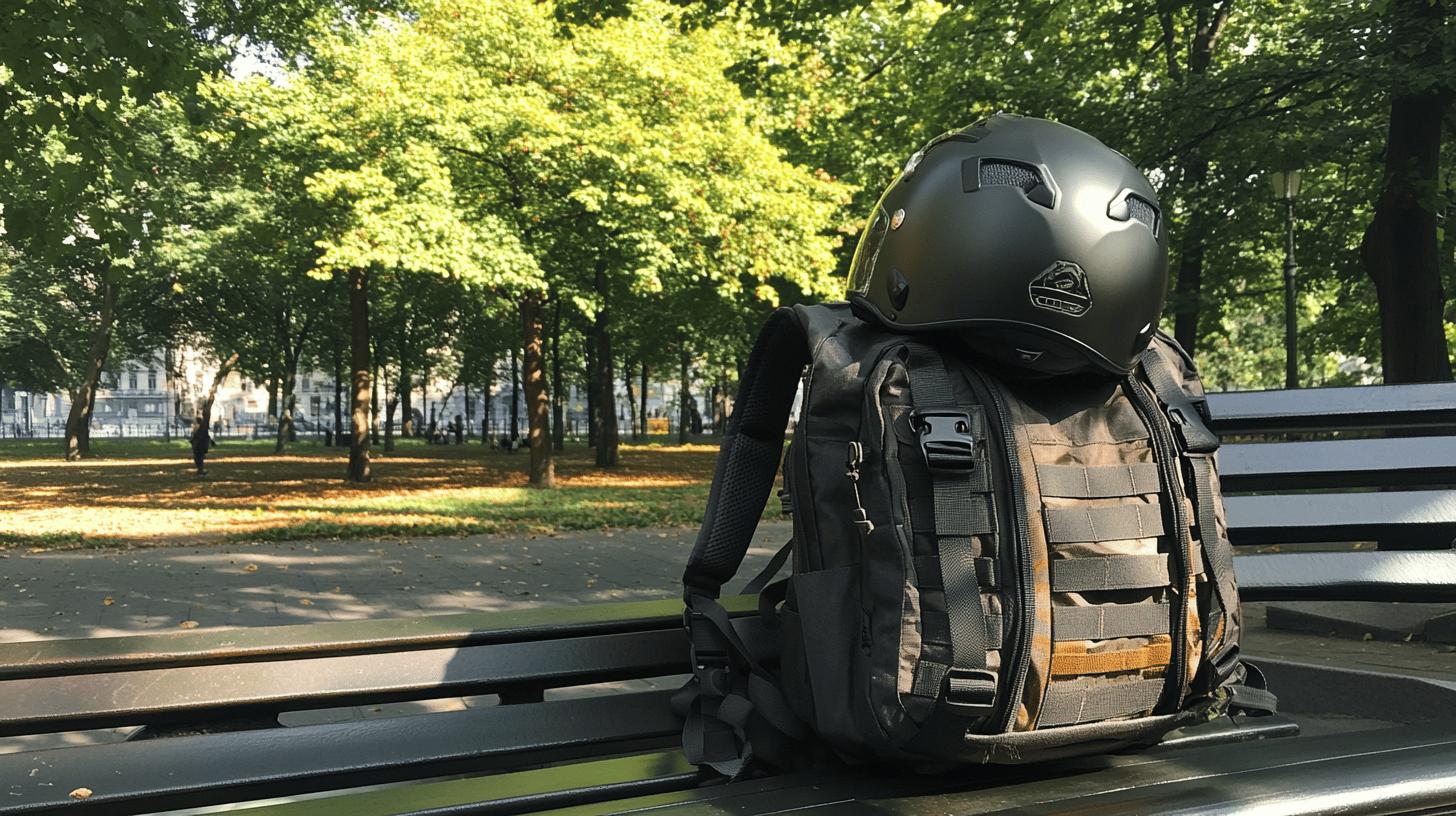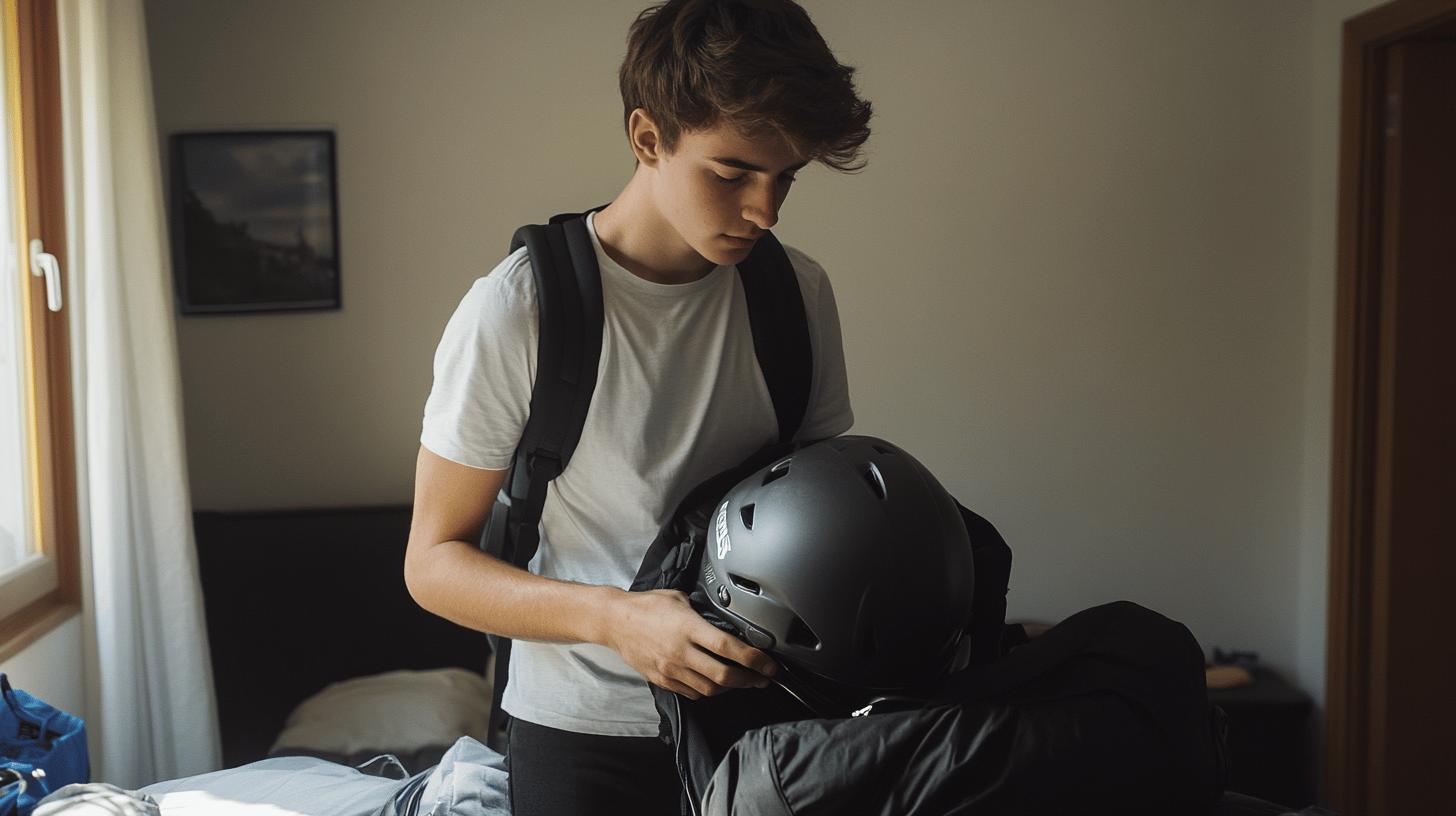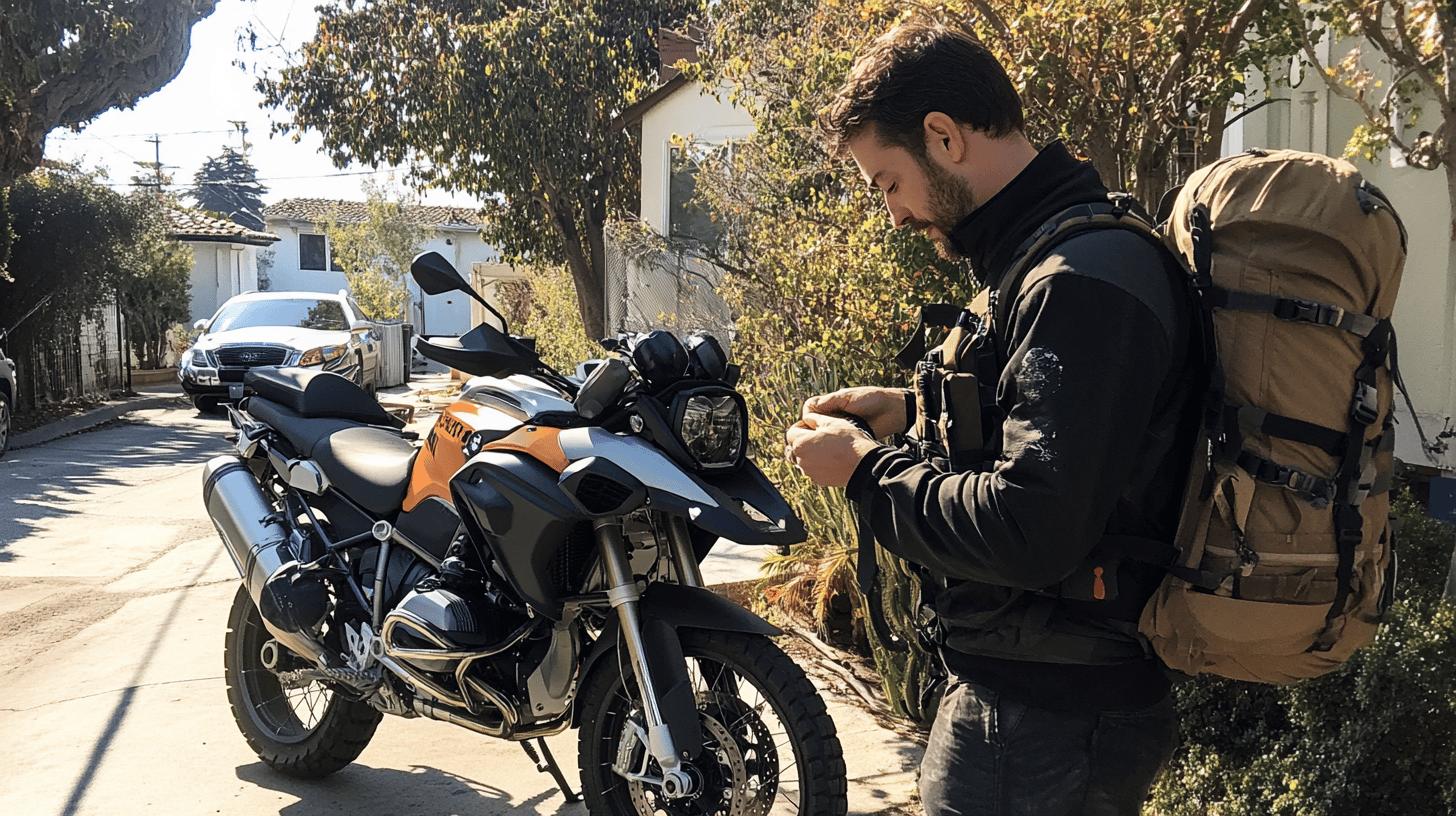Transporting a motorcycle helmet securely while on the go can seem as tricky as navigating a tight corner at high speed. Many riders struggle with the challenge of attaching their helmet to a backpack without sacrificing either safety or convenience.
Learning how to securely attach your helmet can transform your riding experience by ensuring it's safely stowed without the hassle. This article explores various attachment techniques—from shock cords to carabiners—that offer a balance of security and ease, helping motorcyclists keep their helmets safe and snug during transit.
Methods to Attach a Motorcycle Helmet to a Backpack

Attaching a motorcycle helmet to a backpack requires selecting the right method to balance security and convenience. Several techniques can be utilized to keep your helmet secure while allowing easy access when needed.
-
Elasticated Cords and Cord Locks: These shock cords are ideal for creating an adjustable loop, ensuring the helmet is tightly attached to the backpack. Their flexibility allows for a snug fit, adapting to different helmet sizes.
-
Cargo Nets: Typically used for securing larger items, cargo nets are also effective for helmets. They provide broad coverage, which can help in keeping the helmet stable during travel.
-
Bungee Cords: Known for their versatility, bungee cords can be wrapped around the helmet and backpack, providing a firm hold. Their elasticity accommodates various helmet shapes and sizes.
- Carabiners: These are simple, clip-on devices that can attach the helmet to backpack loops or straps. They offer a quick-release option, making it easy to detach the helmet when needed.
Each method has its own advantages and potential drawbacks. Elasticated cords offer the most adjustable fit but may require more effort to secure properly. Cargo nets cover more surface area, reducing movement, but can be cumbersome to attach. Bungee cords are easy to use and adaptable but may not provide the tightest hold.
Carabiners offer convenience with quick-release features but might not secure the helmet as tightly as other methods. Selecting the right attachment method depends on personal preference and specific needs for security and ease of use.
Choosing the Right Backpack for Helmet Attachment

Selecting the appropriate motorcycle backpack for helmet attachment is crucial for ensuring ease of transport, security, and rider comfort. A well-chosen backpack can make a significant difference in how effectively a helmet is carried, especially during long rides or when off the bike.
Features of Ideal Motorcycle Backpacks
When evaluating motorcycle backpacks, look for designs that incorporate dedicated helmet compartments. These compartments are specifically crafted to hold helmets securely, reducing movement and potential damage.
Strong materials are essential, as they provide durability and protection against the elements. Fabrics like Cordura or ballistic nylon are often used for their toughness and resistance to wear and tear.
Ergonomic design is another critical factor, as it ensures comfort while riding. Look for backpacks with padded shoulder straps, adjustable chest and waist straps, and a ventilated back panel to enhance airflow and reduce sweating. These features contribute to a more comfortable carrying experience by distributing weight evenly and minimizing strain.
Comparing Popular Backpack Models
Below is a comparison of some popular motorcycle backpack models that offer features suited for helmet attachment:
| Model | Features | Price |
|---|---|---|
| Alpinestars City Hunter | Dedicated helmet compartment, ergonomic design, waterproof material | $149 |
| Ogio No Drag Mach 5 | Aerodynamic shape, helmet leash system, water-resistant exterior | $199 |
| Dainese D-Mach Backpack | Hard shell construction, padded straps, expandable helmet holder | $189 |
| Kriega R30 | 100% waterproof, strong construction, removable helmet net | $239 |
These models exemplify the range of options available, each offering unique features that cater to different needs and preferences. Choosing the right backpack involves considering the balance of price, functionality, and personal comfort to ensure a hassle-free helmet carrying experience.
Ensuring Helmet Safety and Preventing Damage

Helmet safety in backpacks is a priority for riders who want to maintain the integrity and longevity of their gear. Using padded or specialized helmet compartments is crucial for preventing damage during transport. While regular backpacks can serve the purpose, they often lack the tailored protection that specialized bags offer.
These specialized compartments are designed to cradle the helmet securely, reducing the risk of scratches or impact damage. Ensuring that the backpack provides adequate support and cushioning can make a significant difference in preserving the helmet's condition over time.
-
Use a backpack with a padded or dedicated helmet compartment for optimal protection.
-
Avoid placing heavy items on top of the helmet inside the backpack to prevent pressure damage.
-
Ensure the backpack is securely fastened to minimize movement and potential impacts during transportation.
-
Regularly inspect the backpack for wear and tear, particularly in areas that come into contact with the helmet.
-
Consider using a helmet cover for additional protection against scratches and environmental factors.
Maintaining helmet integrity during transport is essential for rider safety. A well-protected helmet not only extends its lifespan but also ensures that it performs effectively in safeguarding the rider's head during incidents. Consistent checks and mindful packing practices can greatly enhance backpack security for helmets, offering peace of mind while on the road.
Practical Tips for Using Motorcycle Backpacks

Using a motorcycle backpack efficiently is vital for enhancing both comfort and safety while riding. Proper use not only ensures that items are securely stored but also helps in maintaining balance and reducing fatigue on longer journeys.
-
Organize Contents: Place heavier items at the bottom of the backpack to stabilize the load and prevent shifting during rides.
-
Manage Weight Distribution: Distribute weight evenly across both sides of the backpack to maintain balance and avoid leaning.
-
Securely Fasten Items: Use internal straps or compartments to keep items from moving. This prevents distractions and maintains the backpack's structural integrity.
-
Use Multiple Compartments: Take advantage of multiple compartments to separate items, reducing clutter and making it easier to access essentials.
-
Adjust Straps Properly: Ensure shoulder, chest, and waist straps are adjusted snugly to minimize movement and improve comfort.
-
Check for Wear and Tear: Regularly inspect the backpack for any signs of damage, especially around zippers, seams, and straps.
Efficient use of a motorcycle backpack can significantly improve the riding experience by enhancing comfort and reducing strain. Properly organized and secured contents contribute to a seamless journey, allowing riders to focus on the road ahead without unnecessary distractions.
Innovative Helmet Attachment Kits and Accessories

Recent advancements in helmet attachment accessories have significantly improved how riders can securely attach their helmets to backpacks. These innovative solutions are designed to provide both security and convenience, ensuring that helmets remain safely fastened without compromising accessibility.
-
Helmet Locks: These offer a secure way to fasten helmets directly to backpacks. They prevent unauthorized removal, adding an extra layer of security while the helmet is not in use.
-
Backpack Helmet Clips: Specifically designed for ease of use, these clips attach helmets to backpacks effortlessly. They allow quick attachment and detachment, making them ideal for frequent stops.
-
Advanced Carabiners: These are high-strength clips that provide flexibility in attachment points. Their robust design ensures the helmet remains securely fastened to the backpack under various conditions.
- Magnetic Fastening Systems: Utilizing strong magnets, these systems offer a seamless attachment method. They provide a balance between security and quick access, making them popular among tech-savvy riders.
These innovations enhance the overall riding experience by offering practical solutions for helmet attachment. Riders benefit from increased security, knowing their helmets are protected from theft or accidental loss.
Additionally, the ease of use provided by these accessories allows for quick adjustments, ensuring the helmet is always ready for action without unnecessary hassle. As a result, these innovations contribute to safer and more convenient helmet transport, allowing riders to focus on the journey ahead.
Final Words
Exploring the best ways to secure a helmet, knowing how to attach a motorcycle helmet to a backpack efficiently is crucial for every rider. Whether using shock cords, cargo nets, or dedicated backpacks with helmet compartments, options abound.
Combining security with convenience, investing in the right gear ensures helmets remain protected while riding. Adapting these practices not only safeguards equipment but also enhances the overall riding experience, bringing peace of mind and confidence on every journey.
FAQ
Q: How can one attach a motorcycle helmet to a backpack using DIY methods?
A: Using elasticated cords and cord locks, create an adjustable loop. Alternatively, use a cargo net, bungee cords, or carabiners. Each method varies in security and convenience for helmet attachment.
Q: What is the best backpack for carrying a motorcycle helmet?
A: A backpack with a dedicated helmet compartment is ideal. If unavailable, use alternatives like cargo nets or carabiners that securely hold the helmet without specialized compartments.
Q: How can a helmet be attached to an Osprey backpack?
A: Attach helmets to Osprey backpacks using LidLock, a built-in attachment system. This small loop holds helmets securely and conveniently, ideal for bikers and motorcyclists.
Q: Are there tactical backpacks that can hold a helmet?
A: Yes, tactical backpacks with helmet holders exist. They typically feature rugged materials, ample storage options, and specific compartments or attachments for helmets.
Q: How secure are lockable motorcycle helmet bags?
A: Lockable helmet bags provide added security by using locks or locking mechanisms. They deter theft and are available in various styles, including combination locks and padlocks.
Q: Can you fit a motorcycle helmet in a regular backpack?
A: Fitting a motorcycle helmet in a standard backpack is possible but not ideal. Dedicated helmet compartments in motorcycle backpacks provide better space and protection for helmets.
Q: How do you securely store a helmet on a backpack?
A: Secure helmets using padded compartments, specialized straps, or dedicated helmet holders on backpacks. This prevents shifting and potential damage during transport.
Q: What are the practical ways to attach a backpack securely to a motorcycle?
A: Use saddlebag straps, bungee cords, or specialized luggage racks to attach backpacks to motorcycles. These options offer stability and prevent shifting while riding.

Brad Mitchell is a seasoned motorcycle enthusiast with over 16 years of riding experience. He’s spent countless hours on the open road, particularly favoring scenic routes aboard his trusted Harley-Davidson. Brad’s laid-back approach to life and riding gives him a unique perspective on motorcycle gear and safety, which he shares through his in-depth reviews and expert advice on ProtectiveGearz.



